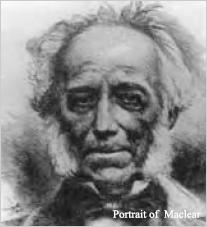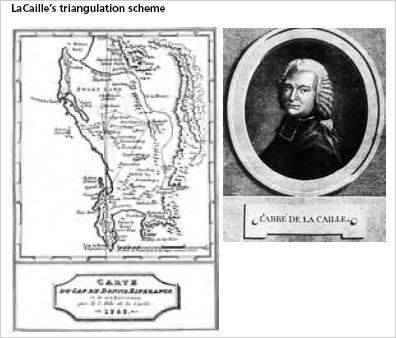| History | |
Everest in South Africa
|
|
||||||||||
|
It was the 25 November 1820 when Everest reached Table Bay and the chance to recover from the fevers to which he had succumbed. Little is known of the year he spent there other than the work he did on the meridian arc that had been observed by M. l’Abbé de LaCaille some 70 years earlier. Prior to leaving India he had discussed with William Lambton, the apparent inconsistency between the arc measured at the Cape by LaCaille when compared with the results from various other measures around the world. Both Everest and Lambton were familiar with observing in the vicinity of large mountain masses and they knew of the experiments of Pierre Bouguer who went on the Peruvian Survey Expedition of 1735.[3] Everest could not make any progress until he had obtained a copy of LaCaille’s Journal from Europe and it was July 1821 before it arrived. Unfortunately it gave little numerical data to go on although he was able to recover some of LaCaille’s station positions. In addition to the base terminals there were four major stations connected in two triangles. LaCaille’s observations had suggested that a degree at 33º S. of 57 037 toises was almost equal to a degree at 45º N. of 57074 toises or, in other words, the earth was more flattened towards the South Pole than towards the North Pole. Was that suggestion correct? In visiting the sites he was struck by the nearness of both the north and south ends of the Arc to mountain masses. Everest considered that rather than any effect at these stations cancelling out it was likely that the reverse would have occurred. In which case the arc would have been too great by the combined effects of the mountains at each end of the arc. To quantify this Everest intercompared various arc measures and from knowledge of the earth’s semiaxes a and b he determined values of the compression of the earth’s form. In taking this to its final stage Everest quoted LaCaille’s arc value from “a very old edition” of Hutton’s Philosophical Dictionary [2], as most of his reference works were still in India, and would appear to have perpetuated a transcription error. The figure of 410 814 Paris feet quoted by Hutton should read 418 014 feet to agree with the measure quoted by LaCaille of 69 669.1 toise. The value is then erroneously turned back to toise as 68 469-the value used by Everest. How easy it is to perpetuate mistakes! [4]. Luckily the effect of the error hardly changed Everest’s conclusion. Where the figures he used gave a difference of 8.99” to attribute to attraction, it should have been 9.15”. From this Everest calculated a need to increase the amplitude of LaCaille’s arc by 8.99” to compensate for the possible effect of local attraction. If this were done the arc would fall into harmony with an ellipticity of 1/300. By 31 December 1821 he was back in India ready to renew his efforts on behalf of the Great Trigonometrical Survey . He summed up his stay in South Africa as “…the fine climate of which had most thoroughly renovated my health…” [1] References1. Everest. G. 1830. An account of the measurement of an arc of the meridian between parallels of 18º 3’ and 24º 7’. Parbury & Co. London. 2. Hutton C. A Philosophical & Mathematical Dictionary. 1795 and 1815 2 vol. London 3. Macdonald, A. S. 1997. From Cape To Cairo: A chronology of the 30th Arc of the Meridian triangulation. S African Journal of Surveying & Mapping. Vol. 24 Pt. 2. 4. Smith. J.R., 1990. You can’t be too careful. S African Survey Journal. December
| ||||||||||















 (4 votes, average: 4.75 out of 5)
(4 votes, average: 4.75 out of 5)




